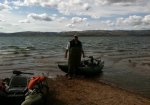Anyone have any good wild game recipes they would like to share? I'll start. In this recipe I use caribou because of my location, but you can substitute white tail deer, elk, bison or any other large game animal. It even works well with beef.
 Caribou Wellington with Bordelaise Sauce
Caribou Wellington
Caribou Wellington with Bordelaise Sauce
Caribou Wellington
2 to 3 pound braised caribou roast (see recipe below)
2 to 3 cups of mushroom duxelle (see recipe below)
1 cup of foie gras pâté
2 fresh eggs, beaten (for the egg wash)
Dijon mustard
Puff Pastry (see below)
2 tablespoons of all-purpose floor
Chopped parsley
Heat the oven to 400°F
Place one of the large puff pastry sheets on a lightly floured chilled surface and with a pastry brush line the edges with the egg wash. Spread an even thin layer of the foie gras pâté over the puff pastry, then spread the mushroom duxelle mixture over the foie gras pâté. Place the braised caribou in the center of the puff pastry, and brush with Dijon mustard. Tightly wrap up the caribou in the puff pastry, tucking in the ends. Egg wash the top and all of the edges carefully. Refrigerate for 30 minutes.
Score and decorate the top of the puff pastry wrapped roast. Put a small hole in the top to allow steam to escape. If you have left over puff pastry you can fashion them into leaves or other decorative items, then with a little egg wash attach them to your wrapped roast to make it more attractive.
Place the wrapped caribou roast in an uncovered, lightly buttered casserole dish, and place in the center of your oven. After about 40 minutes, use a meat thermometer. When the roast reaches between 125°F and 130°F, remove from the oven and let sit for another 15 minutes.
Serves 4
Braised Caribou
2 to 3 pound caribou roast
½ cup of clarified butter
Salt and pepper to taste
In a large frying pan, or baking dish, under high heat, brown the caribou on all sides in the butter to ensure a good seal. Since the roast will be sealed in puff pastry when baked, you do not want it to leak any of its juices into the pastry. Set aside and allow to cool to room temperature.
Mushroom Duxelle
3 tablespoons of butter
1 pound of fresh Portobello mushrooms, cleaned, stemmed, and diced
¼ cup of minced shallots
2 tablespoons of minced garlic
1 cup of Port wine (Madera is a good substitute if port is not available)
Salt and pepper to taste
In a large frying pan melt the butter and add the diced mushrooms. Sauté for 5 minutes, then add the shallots and garlic and continue to sauté for another 5 minutes. Add the port and cook until almost all the liquid has been evaporated or incorporated into the mushrooms. Remove from the frying pan and let cool to room temperature.
Bordelaise Sauce
¼ cup of minced shallots
3 tablespoons of butter
4 ounces of diced bone marrow
1 sprig of fresh thyme
½ cup of good red wine (cabernet sauvignon or merlot)
1 cup of demi-glace (beef stock can be substituted)
Salt and pepper to taste
Melt the butter in a sauté pan and sweat the shallots until they turn translucent, approximately 2 minutes under medium heat. Add the red wine and reduce by half. In a separate pan add the diced bone marrow and just enough water to cover. Bring to a moderate boil, then carefully drain the water and add the marrow to the red wine and shallots. Add the thyme and reduce again by half. Add the demi-glace (or beef stock) and simmer for another 5 minutes until the sauce begins to thicken.
Note: If you substitute beef stock for the demi-glace, you may need to make a rue (equal parts of flour and butter, heated for 3 minutes) in order to thicken the sauce.
Puff Pastry
You can make it from scratch, if you like, but make sure you make enough to cover the entire roast. Or you can buy puff pastry frozen at just about any grocery store. If you buy the frozen puff pastry, you will need two sheets, which should be joined together at one edge using the egg wash. Make sure your puff pastry is not frozen before working with it. Puff pastry should always be kept chilled.








